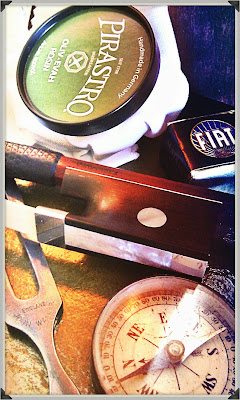A note (Latin
nota)
is a written mark used to represent a sound, letter, word, or action. It is also the sign that something has been
noticed, marked, indicated, noted (Latin
notāre). The score from which I play is a palimpsest
of notations, layer upon layer of notes, in ink, pencil, memory, and
imagination. There are the musical notes
Bach must have written, nigh perfectly transcribed by his wife Anna Magdalena
Bach and by Johann Peter Kellner in the two most authoritative manuscripts of
the four that editors collate to arrive at a text of the suites. (They also use a fifth, an arrangement of the
fifth suite for the lute in Bach’s own hand.)
There is the less consistently recorded order of notation in those
manuscripts that may tell us what articulation Bach expected, though we can
argue about how constraining he would in any case have expected his slurs and staccato
marks to be. There are the
ornaments: signs in shorthand which the
player expands into a trill, turn, or shake.
In some of his other compositions Bach gives us more of these than we
have here, so there is again a possible gap between what we find on paper and
what we may imagine were his expectations.
All these manuscript notes authorise even as they are replaced by the
printed notes of the edition – in my case the superb Peters viola transcription
of Simon Rowland-Jones. And there they
are inevitably joined by editorial notes:
the suggested trills in square brackets, the slurs added for
consistency’s sake with lines through them so we know they are not original,
the hypothetical arpeggiation of the bare five chords at the end of the prelude
to the second suite.
Still, fewer notes than in the Watson Forbes transcription from
which I first learned this music, with its suggested tempo markings and dynamics
and its fingerings (the one, and crucial, editorial intervention that Forbes
does not think to mention in his preface).
Many of us may still be haunted by those notes, which lead the player to
a performance very much of the early 1950s, when Forbes published his version –
keeping string crossings and open strings to a minimum, so the sound can be
smooth and intense. My copy includes the
pencil annotations of many younger versions of me (starting at age 11 or so)
and those of my teachers, first Douglas Reid and then Eta Cohen: fingerings, bowings, dynamics, passages to
push the tempo on and moments to hold it back, and more general technical
instructions (from Eta especially) – ‘Finger action at heel’; ‘Steady
practice’. It has been a relief to put
this copy away and work from a clean copy of Rowland-Jones’s edition.
The wonderful 2012 film ‘A Late Quartet’ depicts a string
quartet trapped by the roles their music has cast them in – the first violin, primus inter pares, the cello who is the
base on which the whole is built, the very dependent second violin and viola,
married and squabbling. They play from
parts in which every nuance of interpretation has been fixed in the detailed
pencil annotations they have established over the years, restricting their
movements like arthritic callus. And
they wonder whether they dare play without the notes. Playing from memory is a strange thing, and
one I have become worse at over the years with the day job making its own
demands on my brain function. You
remember the sound of the notes, but that is not enough. You have a spatial sense of the piece, which
for some of us may coincide more or less with a mental picture of the pages of
music. Most of all, you have muscle
memory – your fingers know where they are going before your mind can think it,
much less send an instruction. These
different kinds of memory are less free than you might think from the
film. Muscle memory requires that one
establish a fingering for the music and stick to it rigidly.
How many notes to add to the notes in my still clean
Rowland-Jones edition, then? Should I
work out all the fingerings and bowings and ornaments and dynamics, or should I
leave as much as possible to chance, or rather to the inspiration of the
moment? Ornaments should sound, and be,
spontaneous, but if one doesn’t at least practice possibilities, one can end up
tying the fingers in knots and messing up badly. My compromise is to work my way towards an
outline interpretation, with habitual fingerings and bowings decided (or
alternatives clearly enough in mind to offer a safe choice in the moment of
performance), with the chiaroscuro of varied articulation, ornamentation, and
dynamic in repeated sections thought through (and again, alternatives at least
mentally noted), but to write down as little of this as possible. Because sometimes forgetting is an important
creative tool, and this way I am free to do things differently next time. There are risks to this
approach, but I am still finding my way.




